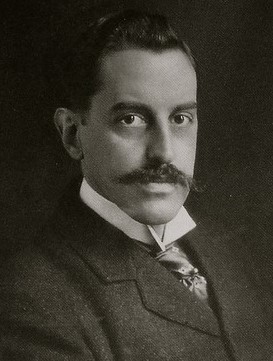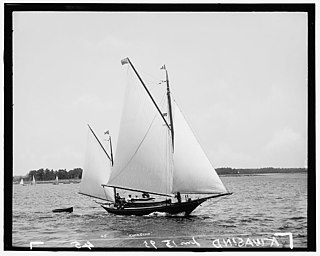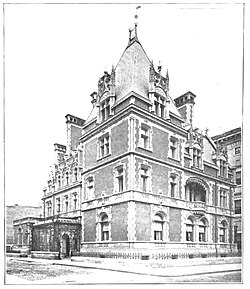
Elbridge Gerry was an American Founding Father, merchant, politician, and diplomat who served as the fifth vice president of the United States under President James Madison from 1813 until his death in 1814. He is known to be the father and namesake of the political practice of gerrymandering.

William Kissam Vanderbilt I was an American heir, businessman, philanthropist, and horse breeder. Born into the Vanderbilt family, he managed his family's railroad investments.

Richard Morris Hunt was an American architect of the nineteenth century and an eminent figure in the history of architecture of the United States. He helped shape New York City with his designs for the 1902 entrance façade and Great Hall of the Metropolitan Museum of Art's Fifth Avenue building, the pedestal of the Statue of Liberty, and many Fifth Avenue mansions since destroyed.

George Washington Vanderbilt II was an American art collector and member of the prominent Vanderbilt family, which amassed a huge fortune through steamboats, railroads, and various business enterprises. He commissioned the construction of a 250-room mansion, the largest privately owned home in the United States, which he named Biltmore Estate.

The Château de Chantilly is a historic French château located in the town of Chantilly, Oise, about 50 kilometres north of Paris. The site comprises two attached buildings: the Petit Château, built around 1560 for Anne de Montmorency, and the Grand Château, which was destroyed during the French Revolution and rebuilt in the 1870s. The château is owned by the Institut de France, which received it from Henri d'Orléans, Duke of Aumale.

Julius LeBlanc Stewart, was an American artist who spent his career in Paris. A contemporary of fellow expatriate painter John Singer Sargent, Stewart was nicknamed "the Parisian from Philadelphia".

Idle Hour is a former Vanderbilt estate that is located in Oakdale on Long Island in Suffolk County, New York. It was completed in 1901 for William Kissam Vanderbilt. Once part of Dowling College, the mansion is one of the largest houses in the United States.

Isidore Konti was a Vienna-born sculptor. He began formal art studies at the age of 16 when he entered the Imperial Academy in Vienna, where he studied under Edmund von Hellmer. In 1886, he won a scholarship that allowed him to study in Rome for two years. While there he developed a love of Renaissance art that was to affect the nature of his mature sculpture. Upon returning to Austria, Konti worked as an architectural modeler.
Robert Livingston Gerry Jr. was an American polo player.

Elbridge Thomas Gerry, usually called "Commodore" Gerry due to the office he held with the New York Yacht Club from 1886 to 1892, was an American lawyer and reformer. His paternal grandfather was U.S. Vice President Elbridge Gerry.

Aimé Nicolas Morot was a French academic painter and sculptor.

The Elbridge Gerry House is a historic house at 44 Washington Street in Marblehead, Massachusetts. Local lore holds that this house is a c. 1730 house that was the home of merchant Thomas Gerry, and the place where statesman and Founding Father Elbridge Gerry was born in 1744. Stylistic analysis of the house, however, suggests that it is instead a late Georgian or early Federalist construction dating to c. 1790.

Chepstow is an Italianate house museum located at 120 Narragansett Avenue in Newport, Rhode Island, built in 1860. It originally served as a summer "cottage", but the Preservation Society of Newport County now owns the property. It was listed in the National Register of Historic Places as part of the Ochre Point-Cliffs Historic District in 1975 and within the Historic District of the City of Newport.

Nymph and Fawn is a public artwork by American artist Isidore Konti and located within the Oldfields–Lilly House & Gardens estate on the grounds of the Indianapolis Museum of Art (IMA), near Indianapolis, Indiana. Created in 1917, the bronze sculpture is also a working fountain. It portrays a female nude pouring water from an urn while standing beside a small fawn.

Franklin Sidway was an American businessman and banker from Buffalo, New York, known for building the Sidway Building in Buffalo, the Spaulding-Sidway house in Grand Island, and commissioning the 1865 painting, Interior with Portraits, by American artist Thomas Le Clear.

Ogden Goelet was an American heir, businessman and yachtsman from New York City during the Gilded Age. With his wife, he built Ochre Court in Newport, Rhode Island, his son built Glenmere mansion, and his daughter, Mary Goelet, married Henry Innes-Ker, 8th Duke of Roxburghe.

Thomas Russell Gerry was an American sailor who was active in the Sons of the American Revolution and was a son of the fifth U.S. Vice President Elbridge Gerry.
Peter P. Goelet, was an American merchant and real estate investor.

Elbridge T. Gerry was a 19th-century New York Sandy Hook pilot boat built in 1888 at the Robinson & Waterhouse shipyard in City Island, Bronx. She was named in honor of Elbridge Thomas Gerry, a commodore of the New York Yacht Club. She served as a pilot boat from 1888 to 1896, when she was sold for offshore yachting cruises. Her name was changed to Kwasind, after the strongman in Henry Wadsworth Longfellow's Song of Hiawatha.
Ancrum House was a Georgian-style manor house constructed from 1925 to 1928 in Delhi, Delaware County, New York. The house was constructed for Angelica Livingstone Gerry (1871–1960) by the firm Cram & Ferguson. Antrum House is historically noteworthy for its formal gardens, designed by the famous landscape architect Fletcher Steele.


















